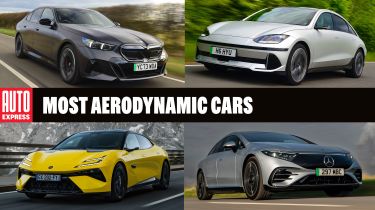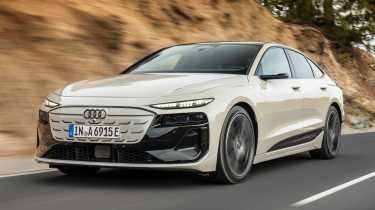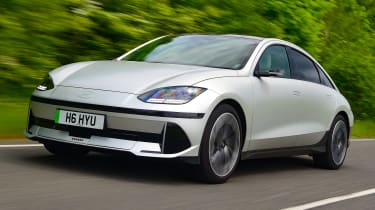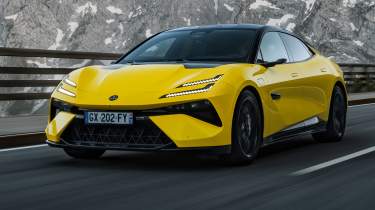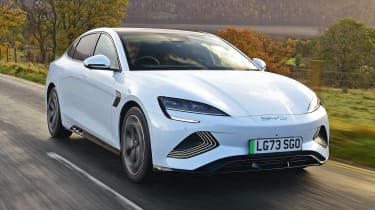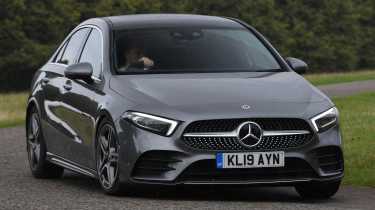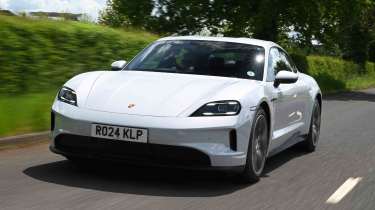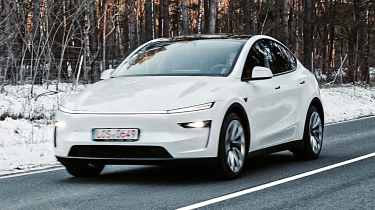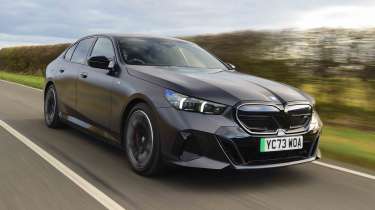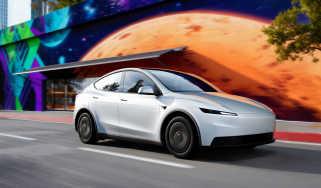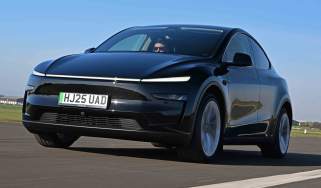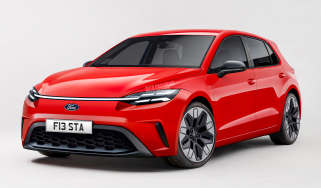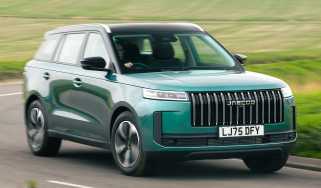Most aerodynamic cars: the sleek, slippery new cars with the lowest drag
Car efficiency is right in the spotlight but there’s more to achieving it than a high-tech powertrain. Good-old aerodynamics are also key, with some cars doing it better than others.
The most aerodynamic cars not only tend to look great thanks to their sleek, low slung styling, they help you reduce the amount you spend on running costs, too. By slipping more easily through the air, these carefully designed machines can use far less energy, particularly at higher speeds.
Aerodynamic design became popular with car buyers in the early Eighties, as increasing fuel costs made manufacturers look for ever more advanced ways to boost efficiency. Expressed as a Cd (Coefficient of drag) figure, these numbers measuring aerodynamic performance became real selling points - the lower the figure, the more effortlessly a car could cut through the air and the more street cred you had. In fact, Audi was so pleased with the 0.30Cd it achieved on its third generation Audi 100 saloon in 1982 that it proudly etched it on the rear quarter light glass.
The recent electric car revolution has reignited interest in aerodynamics, as car companies try every trick in the book to deliver the longest range between recharges. As a result, Cd figures have been tumbling over the last few years, with numbers achieved that would have been unimaginable to Audi’s engineers all those years ago.
As you’d expect, the most aerodynamic new car models feature sleek lines that allow them to slice through the air with minimum drag. That means you’ll be looking at traditional saloons and stylish coupes if you want to drive down your Cd number. However, as our list shows there is the odd SUV and estate car in the mix, too, proving you don’t have to sacrifice space for slippery aerodynamics. Let’s take a look at the top performers.
Mercedes EQS - 0.20 Cd
Effectively the brand’s luxury electric car saloon flagship, the sleek Mercedes EQS is also the most aerodynamic car you can currently buy. With a Cd figure of just 0.20, the all-electric German machine cuts through the air more cleanly than any production car ever made. In combination with the option of a massive 118kWh battery on some models it means the EQS has an impressive WLTP range of up to 511 miles. And even the entry-level EQS350 fitted with a smaller 96kWh battery can manage over 400 miles between charges.
Regardless of motor and battery choice, the Mercedes delivers the sort of hushed and comfortable driving experience you’d expect from a top-of-the-range luxury car. And while the interior trails the brand’s conventionally-powered S-Class for space and quality, features such as the full-width Hyperscreen digital dashboard ensure few can match the EQS’s futuristic appeal.
Audi A6 e-tron - 0.21 Cd
Over 40 years on from its innovative 100 executive car , Audi is still leading the way when it comes to aerodynamic endeavour. The new A6 e-tron doesn’t quite take top honours here, but its 0.21Cd figure is very impressive nonetheless. Aimed squarely at the BMW i5, the A6 is built on the firm’s advanced PPE platform and is available with a choice of 83kWh or 100kWh battery outputs. With the latter fitted, the slippery Audi in mid-spec single motor Performance trim claims a WLTP range of 463 miles.
To achieve its low Cd figure, the e-tron benefits from a number of neat features, including the slim digital door mirrors first seen on the Q8 e-tron. However, the commitment to creating a low roofline means that taller passengers riding in the back of the A6 will find that headroom is a little tight. The roomier Avant estate model addresses this particular problem, but the result is a higher Cd of 0.24.
Hyundai Ioniq 6 - 0.21 Cd
In only a few short years Hyundai has gone from a bargain basement brand to one that has serious premium credentials - and few models demonstrate this better than the Ioniq 6. With its distinctive teardrop profile, this classy four-door electric saloon serves-up a low drag Cd figure of just 0.21 - the same as the Audi A6 E-tron.
Built on the same cutting edge E-GMP platform as the boxy Ioniq 5 hatchback, the Hyundai packs advanced features such as a 800V architecture. This not only allows a 10 to 80% charge in as little as 18 minutes when using a 350kW rapid charger, it also supports Vehicle-to-Load capability that allows you to use the car’s 77.4kWh battery to charge larger electrical items.
Like the Audi, the Ioniq 6 also features a quirky digital door mirror option, and a lack of headroom for rear seat occupants over six feet tall. Moreover, despite its air-cheating exterior and relatively large battery, the Hyudai’s range of up to 339 miles is a little lacklustre.
Lotus Emeya - 0.21 Cd
When Lotus was born back in 1952 its compact sports cars were designed and built around founder Colin Chapman’s philosophy of ‘simplify and add lightness’. However, with a cutting edge EV powertrain and hefty lerbweight of up 2,590kg, the British brand’s Emeya luxury saloon doesn’t really adhere to that old policy. Still, it certainly looks the part, its low slung four-door coupe lines both turning heads and delivering a air-cleaving Cd figure of 0.21Cd.
More importantly, despite its size, sophistication and luxury, the Emeya delivers enough driver thrills to live up to the Norfolk firm’s illustrious history. The flagship R serves-up a pulverising 905bhp and a 0-62mph time of just 2.8 seconds, but for most the standard car’s 603bhp will be enough. With sharp steering and poised handling the Lotus feels lighter on its feet than you’d expect, yet with a supple ride and beautifully crafted cabin it matches many upper class limos for comfort and refinement.
Tesla Model 3 - 0.219 Cd
The first EV to sell more than a million examples, the Tesla Model 3 has become a familiar sight on our roads. With the launch of the ‘Highland’ facelift version last year the American electric car is now also one of the most aerodynamic vehicles out there. Featuring an even lower and slimmer nose, plus various subtle tweaks, the four-door family saloon now has a Cd figure of 0.219.
When combined with the brand’s incredibly efficient powertrain and batteries it allows even the entry-level 60kWh version to travel over 300 miles on a charge. On Long Range models equipped with a 79kWh battery this figure increases to as much as 436 miles. Better still, the mid-life update introduced a classier and better-built interior together with suspension tweaks that result in a nicely judged ride and handling balance. Less impressive is the designers’ decision to ditch column stalks, meaning the indicators are now operated by fiddly buttons on the steering wheel.
BYD Seal - 0.219 Cd
You can’t fault the ambition of Chinese brand BYD, which is targeting premium models such as the Tesla Model 3 and BMW i4 with its quirkily named Seal saloon. With a similar, aerodynamically advantageous teardrop shape to the Hyundai Ioniq 6, the BYD (it stands for Build Your Dreams) features an impressively low Cd of 0.219.
There’s a choice of single or dual motor layouts, with the latter offering a thumping 523bhp and 0-62mph in 3.8 seconds. However, the standard 308bhp model is no slouch, plus it serves-up a longer WLTP range of 354 miles (both versions use the same 82.5kWh battery). It’s not as sharp to drive as an i4 or as fast-charging as a Model 3, but the Seal is refined and well-equipped. Moreover, it benefits from a surprisingly spacious and classy interior that matches more expensive models for build quality and premium materials
Mercedes A-Class - 0.22 Cd
If you thought this list was all about EVs, then the A-Class Saloon will make you think again. When it was launched in 2018 the German brand claimed it was the most aerodynamic car in the world - and while its Cd figure of 0.22 has been surpassed, it’s still a pretty slippery customer. Sleek, almost coupe-like lines help the four-door A-Class cut effortlessly through the air, although it's only the entry-level A180 and plug-in hybrid A250e that achieve the headline aero number.
Like the hatchback model it's based on, the Saloon has one of slickest and upmarket interiors in the business, while its MBUX infotainment is great to use and packed with features. Better still, its longer body trades a bit of the five-door model’s versatility for an even bigger 460-litre boot (although the plug-in’s battery means it only musters 390-litres). Factor-in grown-up driving dynamics and the option of racy Mercedes-AMG versions, and the A-Class saloon is a desirable wind-cheating choice.
Porsche Taycan - 0.22 Cd
The Porsche Taycan is the car that proved EVs can be fast and fun as well as environmentally friendly. Facelifted in 2024, the rapid German saloon is not only quicker and even better to drive, refreshed looks mean it's also more aerodynamic.
Boasting a figure of 0.22 Cd it’s not the most aerodynamic car in this list, but it is the slipperiest shape Porsche has ever created. There’s a choice of 89kWh or 105kWh batteries (the latter being called the Performance Battery Plus), with the bigger pack combining with the enhanced aero to deliver a WLTP range of up to 421 miles.
Like the Hyundai Ioniq 6, the Porsche features powerful 800V architecture, which means that at the fastest DC chargers it can zapped from 10 to 80% charge in as little as 18 minutes. Crucially, despite this extra efficiency the Taycan still drives like a Porsche, which means electrifying acceleration and handling that makes it almost as engaging and entertaining as the firm’s iconic 911 sports car.
Tesla Model Y - 0.22 Cd
Combining family-friendly practicality and space with Tesla’s trademark EV tech and usability, it’s no surprise the Model Y has been a huge sales hit. Now there’s a heavily revised version that aims to build on the success of a machine that crosses the boundary between SUV and MPV.
One of the most obvious changes is the exterior styling, which benefits from a sleeker new nose (complete with full width light bar) that helps the car achieve an impressive Cd figure of 0.22. As a result, the Long Range model now claims 387 miles between charges, which is an increase of 14 miles over its predecessor. As before, there’s a choice of single and dual motor layouts, with the latter offering 444bhp in its most powerful Launch Edition guise. Tweaks to the chassis have resulted in sharper handling and a more composed ride, while noise levels have been reduced thanks to enhanced insulation and acoustic glass. More importantly, unlike the recently revised Model 3, the Y retains its traditional indicator stalk.
BMW i5 - 0.23 Cd
You might not believe it when looking at the i5’s vast and bluff-fronted grille, but this is one of the most aerodynamic models BMW has ever built. Essentially the all-electric version of the brand’s latest 5 Series executive saloon, this large four-door machine serves-up an impressively low Cd of just 0.23.
The firm’s engineers have obsessively chased aerodynamic performance, with features such as a flat underfloor, special wheel designs, air curtains and electrically powered flap in the grille that only opens when the battery needs cooling. In total, BMW claims these features help extend the range by 29 miles, taking the entry-level eDrive40’s WLTP total to 357 miles from an 81.2kWh battery.
Despite its imposing size and weight (the flagship M60 tips the scales at just over 2,300kg), the i5 retains the brand’s trademark agile and engaging driving dynamics. It’s also comfortable and refined, while the vast interior oozes premium appeal and is crammed with cutting edge tech.
What makes an aerodynamic car and why should car buyers care?
When looking at the drag coefficient figure of a new car, it’s important to bear in mind that it's unlikely all versions of the model will have the same aero figure. If you take the models in our list as an example, then the number quoted will be for the entry-level model that features the narrowest tyres and no sporty body kit extras.
What’s more, aerodynamic efficiency is only one of a number of factors that dictate how efficient a car will be. The type of motor or engine under the bonnet will play a big part, as will the size and weight of the model as a whole. However, without doubt the biggest influence on battery use or fuel economy will be the behaviour of the person behind the wheel - if you’ve got a heavy right foot, then it won’t matter too much whether your motor has a Cd of 0.20 or 0.40.
Finally, while all the cars in our list are at the cutting edge of low drag aerodynamics, they behave like barn doors when compared to some of the most advanced concept cars. As far back as 1954 the voluptuous Alfa Romeo BAT 7 show car boasted a Cd figure of just 0.19, while in 2000 General Motors previewed Precept, an 80mpg diesel-electric hatchback with a 0.16 Cd. Yet the sleekest vehicles ever are the low slung prototypes that compete in various economy marathons around the world. For instance, Delft University of Technology’s Eco Runner 8 delivered a Cd figure of only 0.045. Now that is an aerodynamic car.
